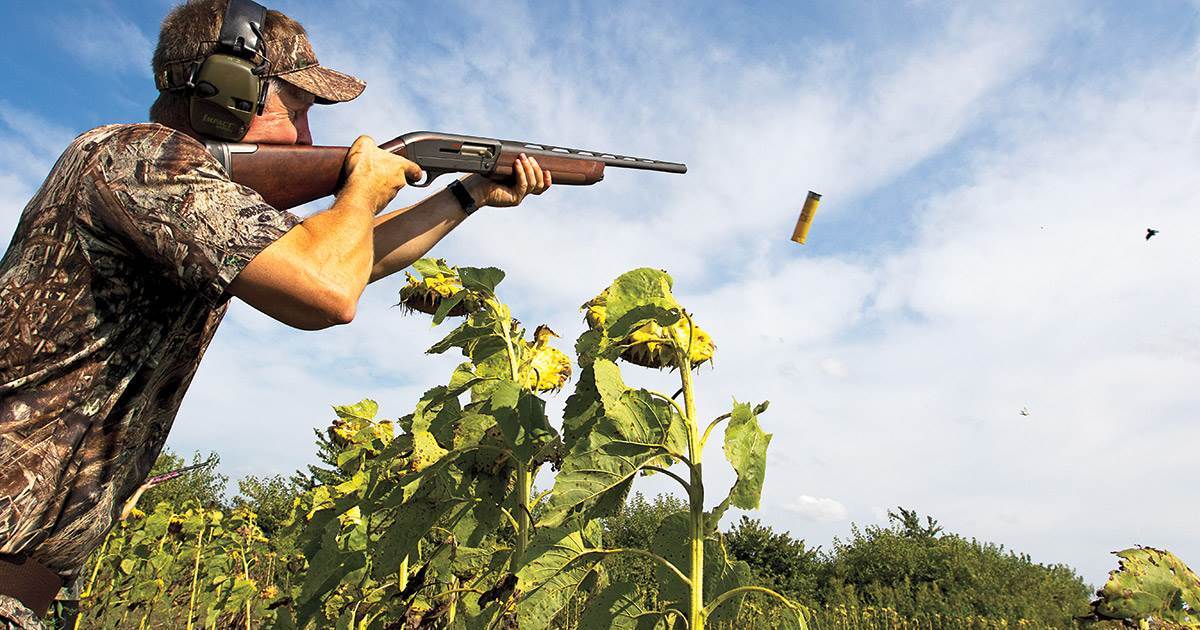Shotgunning: Early Birds
Dove hunting is the perfect tune-up for waterfowl season
Dove hunting is the perfect tune-up for waterfowl season


Dove hunting can be a lot like waterfowl hunting. In a dove field, you'll see many of the same crossing, incoming, overhead, and decoying shots that you'll be presented with later on during waterfowl season. The only difference is that doves are smaller and faster, and you're sweating, not shivering. Keep the following advice in mind as you take the first shots of the new hunting season.
Dove hunting lets you get back in touch with your shotgun after a long off-season. Use the same gun you'll be using for ducks and geese, and switch to an improved cylinder choke to give yourself more pattern spread at typical dove-shooting distances. Don't worry about matching the velocity of your duck-hunting loads. At the closer ranges that are typical of dove shoots, a difference in velocity doesn't matter. You're better off shooting a slower, lighter-kicking load and focusing on your technique.
Usually, you see doves coming from a long way away. The temptation is to mount your gun early and track the bird as it comes to you. Do that, and you risk aiming, which is the best way to stop or slow your swing and miss. Instead, wait until the bird is close, and then bring the gun smoothly to your cheek while keeping your eye on the bird. Think about pushing the muzzle out toward the bird, then raising the gun to your face to make a clean gun mount. Do that now, and it will pay off later. Pushing the gun out to the target helps keep the butt from snagging on your clothes. It matters during dove season, and it matters even more when you're all bundled up in cold weather.
The natural tendency, especially with speedy mourning doves, is to move the gun too quickly. Rushing your mount and your swing increases the chance that you'll mount the gun poorly, which means that it probably won't shoot where you are looking. Swinging too fast also ruins your feel for the target. Since your eyes are drawn to the fastest-moving object in your field of vision, hurrying increases the chance that you'll look at the gun, rather than the bird. No matter how fast or slow the bird, your goal should always be to match your gun speed to the speed of the target, and to maintain that speed all the way through to the end of the shot.
Train yourself to dial down your focus on the target. If you look at the bird's head, you'll hit the front end of the bird. This is especially important in waterfowl hunting, where a hit too far back can result in a bird that flies off carrying shot, or in a baffling miss. If a dove is close enough, try to focus on its beak or eye. If you can do that, you'll be ready for anything duck or goose season brings.
If you've been shooting clays all summer, you should be in sync with those targets, but you may find yourself shooting in front of doves. Clays require more apparent lead than live birds do. The solution is to think less about lead and more about focusing on the target. The better the visual information you send to your hands, the better your hands will know where to put the gun, as long as your conscious brain doesn't override them and cause you to over-lead.
Most people don't mind missing doves, because they know that everybody does. And if they do miss one, another will probably be along shortly. This attitude keeps dove hunting fun, and it also happens to be the best way to shoot well. Take every good, safe, ethical shot that comes your way, and you'll have a better hunt while reinforcing good habits you can rely on later. Enjoy the hits, learn from the misses, and move on. The dove field is a great place to learn these lessons.
Ducks Unlimited uses cookies to enhance your browsing experience, optimize site functionality, analyze traffic, and deliver personalized advertising through third parties. By continuing to use this site, you agree to our use of cookies. View Privacy Policy